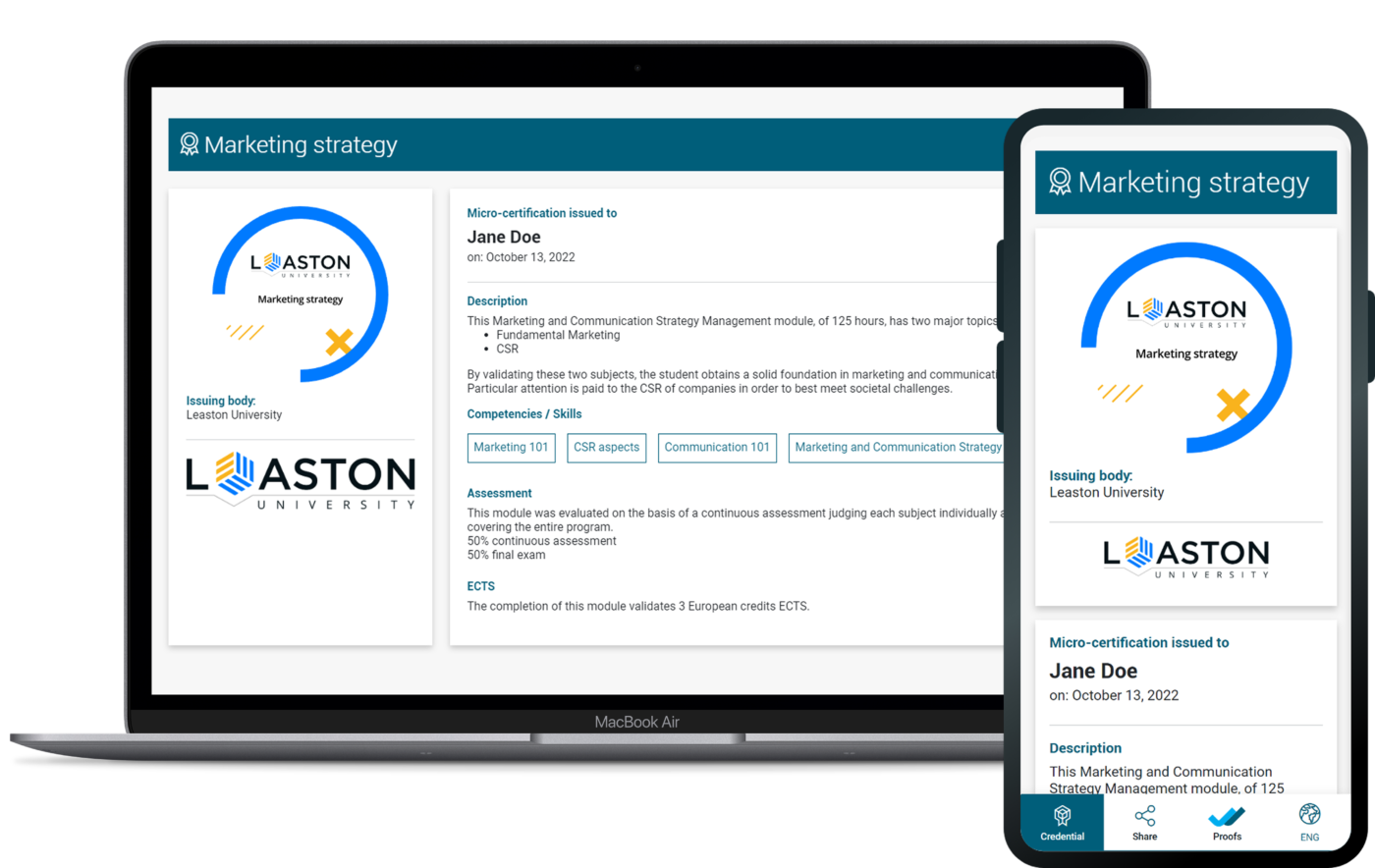The landscape of academic recognition and learning is changing. As education and online learning evolve beyond traditional classroom walls, institutions need new ways to certify the diverse skills and knowledge their students acquire. This has led to the rise of a powerful new tool: the digital badge. This guide explicitly answers the most common questions about this transformative technology, explaining what digital badges are, why they are essential for modern education, and how they are being used to redefine achievements.
What Are Digital Badges? A New Form of Credential
To understand the power of a digital badge, think beyond the simple image or icon. Answering what are digital badges? requires looking “under the hood” of this innovative digital credential technology.
A digital badge is a secure, portable, and verifiable online record of an accomplishment. While it has a visual icon, its real value is in the rich data embedded within it. This data provides context, legitimacy, and detail that a paper certificate cannot. Every badge is built on a framework of information, often following the Open Badges standard first developed by the non-profit Mozilla. This framework for issuing a credential includes:
- The Issuer: The institution or organization that awarded the badge.
- The Recipient: The individual student who earned the badge.
- The Criteria: A detailed description of what the person had to do to earn the recognition, including the learning outcomes and assessment methods.
- The Evidence: A link to the work, project, or exam that proves mastery of a skill.
- The Issue Date: A timestamp showing when the badge was conferred.

This structure transforms a badge from a decorative icon into a verifiable certificate. It’s shareable across social media, online portfolios, and email signatures, allowing anyone, including potential employers, to click and verify its authenticity over time.
Why Are Digital Badges Used in Education? The Core Benefits
The next logical question is, why are digital badges used in education? The answer lies in the unique benefits of digital badges for everyone in the academic ecosystem, from individual learners to the issuers themselves. They provide a new engine for motivation, recognition, and granular skill validation that will help institutions and students alike.
For Scholars and Individuals
For the person earning them, badges are a powerful tool for personal and professional development.
- Motivation and engagement: Digital badges break down long-term learning into achievable milestones. This provides a regular reward and positive reinforcement that motivates individuals to engage more deeply with their studies.
- Making skills visible: digital badges for students, just as digital badges for employees, allow their recipients to showcase specific skills and competencies—like proficiency in a programming language or a lab technique—that are often hidden within a course grade or on a transcript. This helps them better communicate their qualifications.
- Personalized learning pathways: Individuals can collect badges from various courses, workshops, and extracurricular activities to build unique learning pathways. This process helps them form a portfolio that tells a rich story of their specific abilities and interests.

For Educational Organizations and Issuers
For universities and schools, issuing digital badges is a strategic way to enhance their educational programs and reputation.
- Recognizing the full scope of learning: Institutions can formally recognize valuable learning achievements that happen outside of traditional programs, such as in workshops, volunteer initiatives, or student leadership roles.
- Gaining curricular insights: Data from a badging program can reveal which skills are in high demand and how effectively they are being taught across different departments, helping to inform curriculum development.
- Enhancing institutional reputation: By issuing secure, verifiable certificates for sought-after competencies, organizations demonstrate a commitment to innovation and producing highly capable graduates.
How Are Digital Badges Used in Education? Practical Implementation
Answering the question “how are digital badges used in education?” involves looking at the process to create and award them. A successful badging program is not just about technology; it’s a pedagogical strategy that requires careful planning and execution by issuers.
First, an institution must define clear standards. A badge is only as valuable as the rigor behind it. This means establishing clear learning outcomes and robust assessment criteria for each badge you want to issue. What must a person learn or do to earn this specific credential?
Second, the badges themselves must be designed and awarded. This involves a thoughtful design process to create a visual representation that aligns with the institution’s brand. It also requires a process for conferring the badge upon successful completion of the requirements. The key is to create digital badges that are both meaningful and easy to manage.
Finally, this all requires the right technology. A secure and user-friendly system or platform is essential. The chosen technology, or badging platform, must handle the entire life cycle of a badge—from issuing it to managing its verification over time. This is where a trusted digital badge maker becomes a critical partner.
What Are Some Concrete Examples and Applications of Digital Badges?
Perhaps the best way to understand their impact is to ask, “what are some concrete examples and applications of digital badges used in education?” Here below we give a few real-world scenarios across different educational levels. This list of digital badge examples will help illustrate the possibilities.
Examples in Higher Education
- Research skills: A university’s graduate program could, for example, issue a badge for “Advanced Quantitative Analysis” to a PhD candidate who completes a specialized methodology workshop. This badge would represent a core research competency.
- Technical proficiencies: A digital humanities department might offer a badge for “Python for Humanists,” certifying a valuable technical transversal skill that makes students more attractive to employers.
- Co-curricular learning: A university’s career center could award a badge for “Leadership Development” to a student who completes a multi-stage leadership program and mentorship, showcasing key soft skills.
- Safety and compliance: A science faculty could require all students to earn a “Certified Lab Safety” badge before they can access certain laboratories, a credential that proves essential knowledge.

Examples in School Education
- STEM achievements: A middle school might reward a student with a badge for “Robotics Team Project Lead” to recognize leadership and technical skill development in an extracurricular club.
- Digital citizenship: An elementary school could have a curriculum that lets young pupils learn and earn a “Responsible Online Communicator” badge, one of a series of badges in their development pathway.
Soft skills: A high school could bestow a “Public Speaking Excellence” badge on members of its debate team who demonstrate superior performance, a key achievement to show to higher education institutions.
The Future of Recognition: The Role of Blockchain
As educational institutions increasingly adopt digital badges, the question of long-term security and trust becomes paramount. This is where blockchain technology provides a revolutionary answer. When a badge is anchored to a blockchain, it becomes an unforgeable and permanent record. It cannot be altered or faked, guaranteeing the integrity of the accomplishment. More importantly, a blockchain-based credential truly belongs to the individual, existing independently of the issuer or any platforms. This is the future of trusted, lifelong learning records.
Why Choose Our Secure Badging Platform?
Ready to issue credentials as innovative as your curriculum? Your institution needs a service that combines unwavering academic integrity with cutting-edge security on a single platform.
The BCdiploma blockchain-based solution makes it simple to build a world-class badging program. We provide unmatched security to protect your reputation and your scholars’ achievements, ensuring every qualification is permanent and verifiable.
Our intuitive tools allow you to design and issue meaningful badges with ease, empowering you to recognize every step of the learning journey. We put people in control of their own attainments, providing them with qualifications that hold indisputable, real-world value. Establish a future of trusted, verifiable learning. Contact us today to learn how our platform can help you establish your digital recognition initiative.
Frequently asked questions
Contact us for more information.
A digital badge is a secure, portable, and verifiable digital record of an achievement, enriched with metadata such as issuer, recipient, criteria, evidence, and date—not just a decorative image.
For learners: motivation, visibility of skills, and personalized learning paths. For institutions: recognition of diverse learning, curriculum insights, and enhanced reputation.
Institutions must set clear standards, design visually consistent badges, and use a secure platform to manage the full badge lifecycle from issuance to verification.
